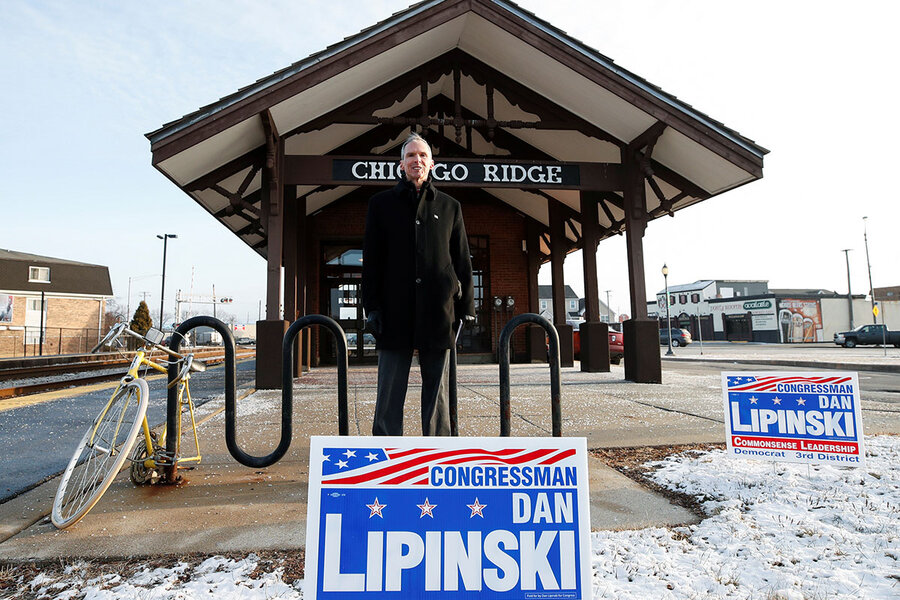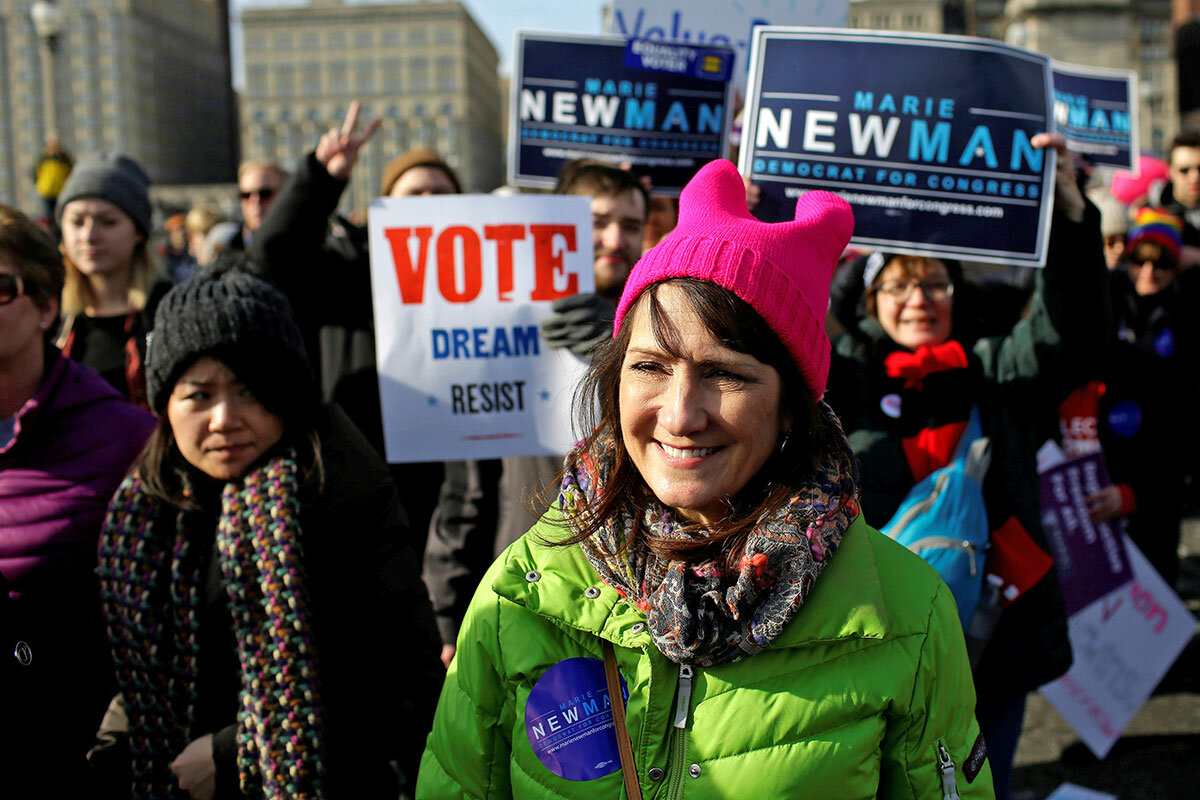In Illinois, Democrats face a test of big-tent values
| WASHINGTON
In recent days, dozens of anti-abortion activists, mostly college students giving up their spring break, have descended on the Chicago suburbs to canvass for votes – for a Democrat.
Rep. Dan Lipinski of Illinois is something of an endangered species: one of the last Democrats in the House of Representatives who consistently votes against abortion rights. And he is facing extinction, in the form of a serious primary challenge from an abortion-rights political neophyte, Marie Newman, in the Illinois primary on Tuesday.
It’s not the only battle between Democrats this primary season. In suburban House districts from Boston to Houston, to the US Senate race in California, progressives newly energized in the era of President Trump are challenging establishment Democrats from the left. The efforts are testing the poles and guylines that hold up the supposedly “big tent” party. They also underscore a fundamental tension for Democrats heading into the midterm election season: Is the party better off focusing on its activist base and driving up enthusiasm? Or should it be tacking to the center, in an effort to win back some Trump supporters?
Ms. Newman labels her opponent a “Trump Democrat,” while her supporters send out fundraising emails to help her oust this “DINO” (Democrat in name only) who “inherited” his seat from his father. A March poll conducted for the abortion rights group NARAL, which backs Newman, had the race at a statistical tie, with Congressman Lipinski slightly edging out his opponent, 43 percent to 41 percent.
To Newman, the conservative Lipinski no longer fits with this district in the southwest Chicago suburbs. An area that is home to Midway Airport, it was once heavily populated with working-class Irish Catholics and Poles. Now it’s got hipster enclaves and is 30 percent Hispanic.
For his part, Lipiniski likens the insurgencies of progressives like Newman to the “tea party of the left.” A seven-term congressman, whose father held the seat for six terms before him, he co-chairs the Bipartisan Congressional Pro-Life Caucus in the House, as well as the shrinking caucus of moderate Blue Dog Democrats. He voted against the Affordable Care Act, the Dream Act to protect young, unauthorized immigrants, and had opposed marriage equality.
But as his district changed, so have some of his positions. He voted against the GOP effort to repeal Obamacare, and now says he supports marriage equality and would vote for the Dream Act.
He’s still anti-abortion, however – and this has become a focal point in the campaign. While Democratic leaders such as House minority leader Nancy Pelosi and New Mexico Rep. Ben Ray Luján, who heads up the House Democratic campaign arm, maintain that there is no “litmus test” over the issue, progressives see it differently.
Both NARAL and Emily’s List, which supports abortion-rights female candidates, are backing Newman, as is Rep. Jan Schakowsky (D) of Illinois, a member of the House Progressive Caucus.
“I assure you that this district is overwhelmingly pro-choice,” Congresswoman Schakowsky said at a press conference last month, where her Democratic colleague Rep. Luis Gutierrez, also of Illinois, backed Newman. He faults Lipinski for his views on immigration. “He would be all right in Congress in 1996,” Congressman Gutierrez said.
The two lawmakers have split from the Democratic congressional leadership, which traditionally backs incumbents and is supporting Lipinski, along with the AFL-CIO and the local Democratic political machine.
“I support Dan Lipinski in this particular race. We are a big-tent party,” said Rep. Joseph Crowley (D) of New York, at a press conference last week. Mr. Crowley chairs the Democratic caucus in the House.
Regardless of who wins on Tuesday, this is a safe Democratic seat – as is the case in several other high-profile Democratic primary battles. In the Boston area, Rep. Michael Capuano, who is much more liberal than Lipinski, is trying to fend off a primary bid from Ayanna Pressley, the first African-American woman elected to the Boston City Council. In California, veteran Sen. Dianne Feinstein is being challenged by the progressive state Senate leader Kevin de León. She is the only Democratic senator facing a primary challenge – and is expected to win.
That’s a point that independent political observer Nathan Gonzales, editor of Inside Elections, wants to bring home.
“We’re not seeing a large number of challenges to incumbents,” he says. “At the same time, I think we are seeing an anti-establishment left forming.” In some instances it’s being driven by ideology, while in others it may be as much a desire to throw out the old guard in favor of some fresh faces. Senator Feinstein, for instance, is an octogenarian; leader Pelosi, a septuagenarian.
“Some of the civil war that the Republicans have been going through for nine years is in the beginning stages within the Democratic Party,” Mr. Gonzales says, pointing to the rise of the Bernie Sanders wing of the party. (Senator Sanders of Vermont is himself an Independent.)
Should Democrats retake the House, it’s hard to say what the tension between the left and center wings of the party would mean in terms of governing.
Bill Schneider, former senior political analyst for CNN, now at the University of California at Los Angeles, points out that the liberal constituency has always been there – but feels its “time has come” now that Hillary Clinton, seen as the establishment, has been defeated.
“If Democrats win a majority in the House, it will be a matter of weeks before a bill of impeachment is filed [against Trump], and that will be the main story thereafter.”
Others don’t see it that way. In order to flip the House, Democrats will have to win many GOP swing districts and make inroads into rural ones, with candidates who “fit” with those constituents. It was a more conservative Democrat, for instance, who won the special election in Pennsylvania’s 18th district last week.
“Impeachment is in the Constitution and must remain a last resort, not the first thing you turn to when you don’t like who’s in charge,” says Rep. Gerry Connolly (D) of Virginia. “If we win, we have to be perceived as fair, and not in a rush to judgment. We can’t look like a bunch of Salem witch judges.”
Congressman Connolly warns against ideological purity and orthodoxy, and says he has personally felt ostracized by more progressive members on one of his issues, free trade. “I didn’t always feel that my party was going to protect me for daring to represent my district,” he says. “As an individual member, I didn’t feel my party had my back.”










